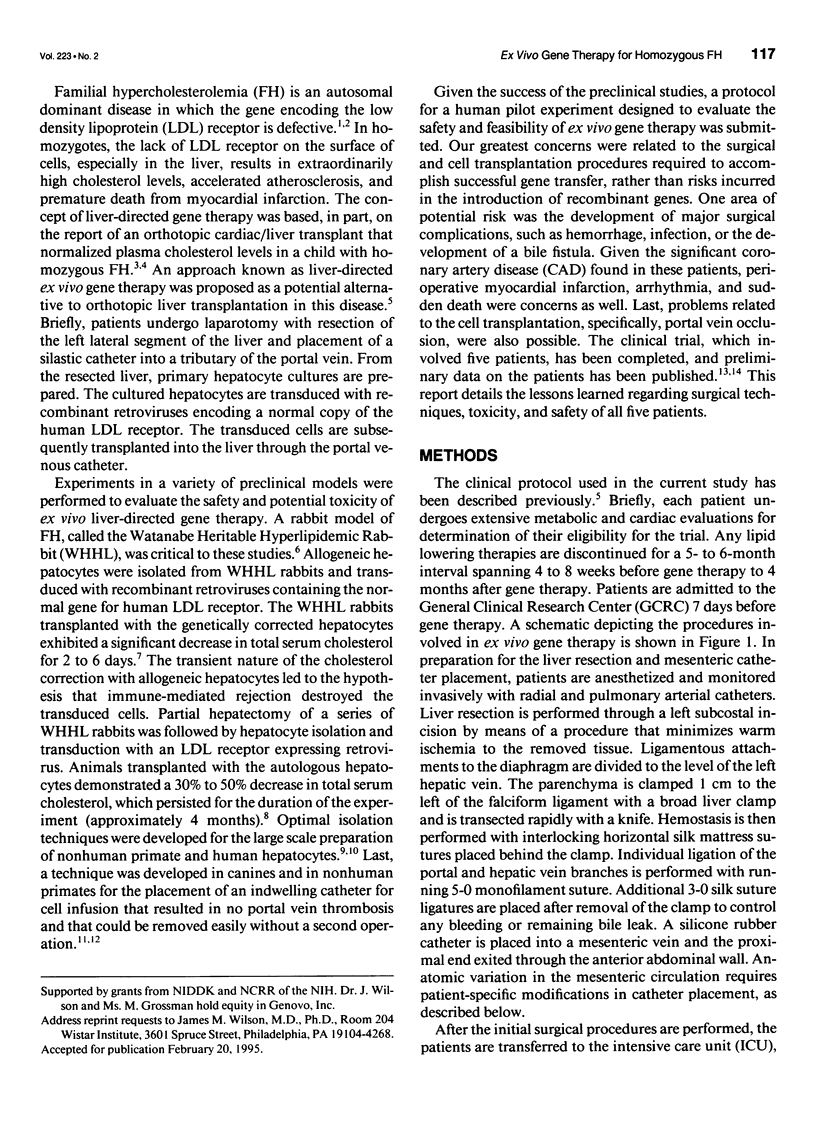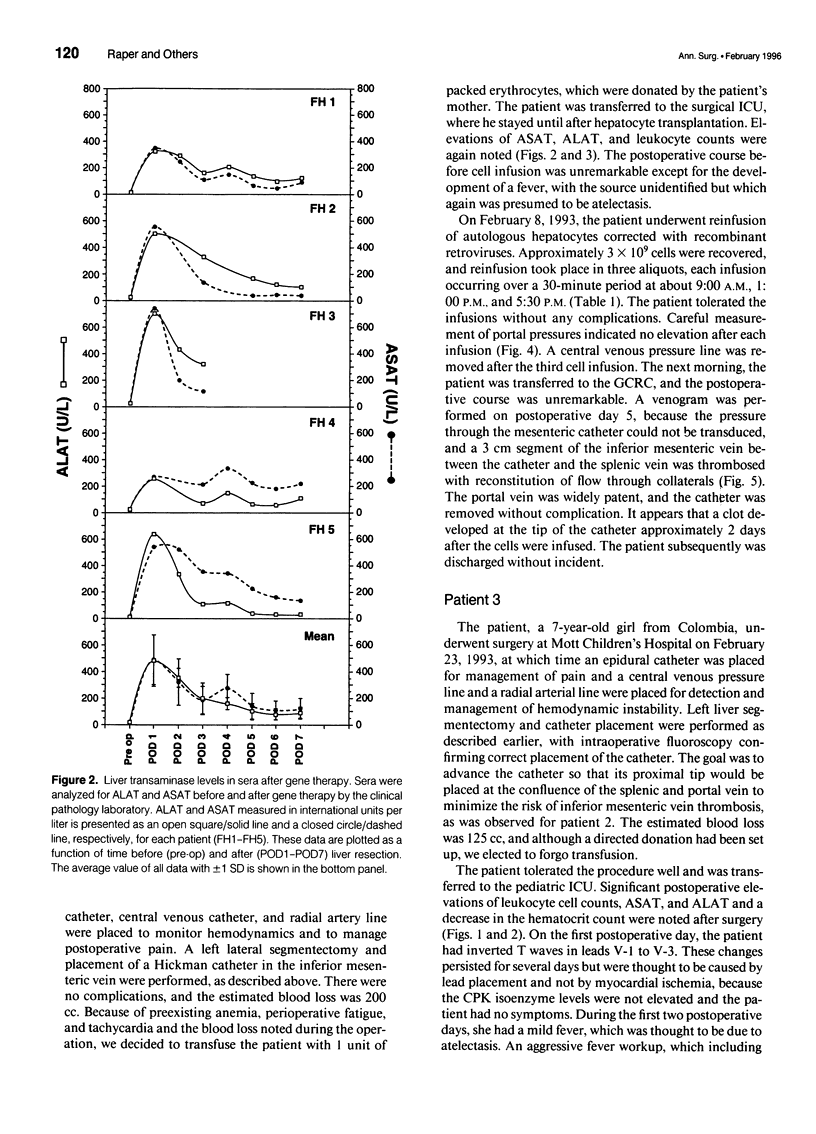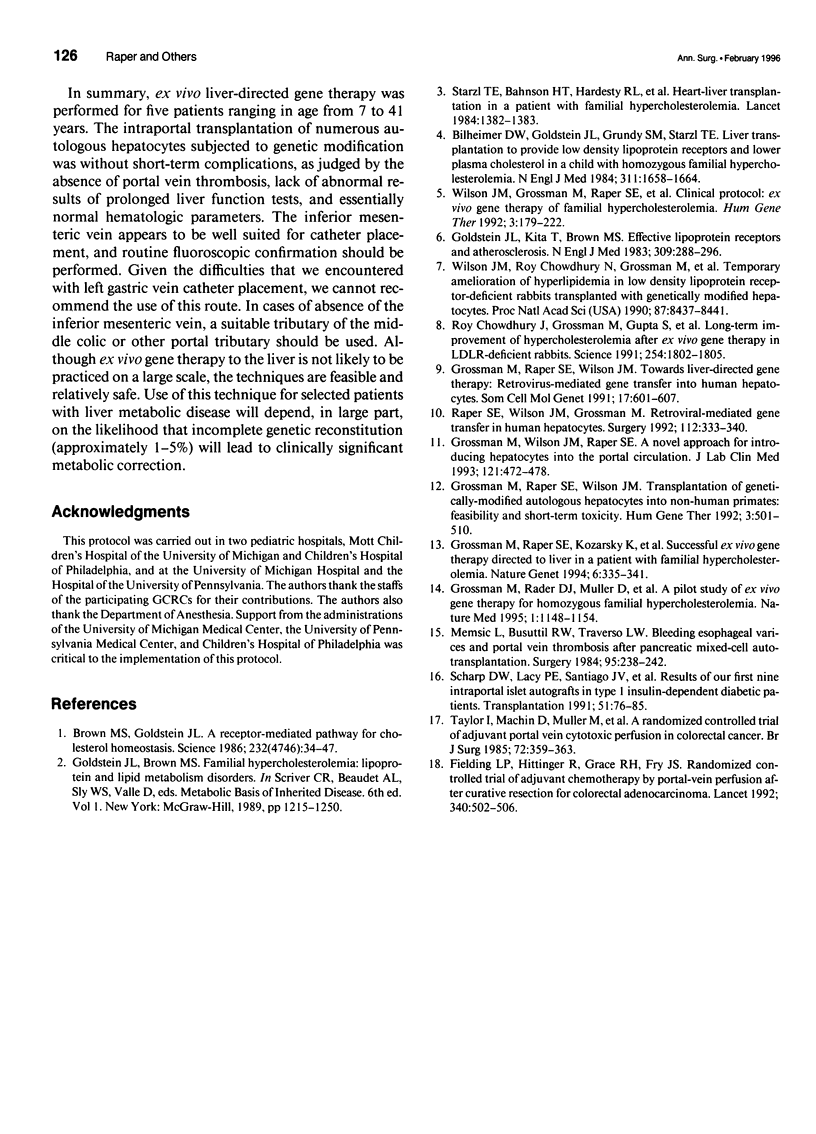Abstract
OBJECTIVE: The purpose of this report was to provide detailed information on the safety and feasibility of surgical procedures associated with the first ex vivo liver-directed gene therapy trial for the treatment of vivo gene therapy for homozygous familial hypercholesterolemia (FH). SUMMARY BACKGROUND DATA: Familial hypercholesterolemia is an autosomal dominant disease in which the gene encoding the low density lipoprotein receptor is defective. Patients homozygous for this mutation have extraordinarily high levels of cholesterol and accelerated atherosclerosis and die prematurely of myocardial infarction. The concept of liver-directed gene therapy was based on the report of normalization of cholesterol levels by orthotopic cardiac/liver transplant in a child with homozygous FH. METHODS: Five patients with homozygous FH were selected for inclusion in this trial. The patients underwent hepatic resection and placement of a portal venous catheter. Primary hepatocytes cultures were prepared from the resected liver and transduced with a recombinant retrovirus encoding the gene for the human low density lipoprotein receptor. The genetically modified cells were then transplanted into the liver through the portal venous catheter. RESULTS: Numerous clinical, laboratory, and radiologic parameters were analyzed. Elevations of the hepatic transaminases and leukocyte counts and a decline in hematocrit count were noted. Transient elevations of the portal pressure were observed during cell infusion. No major perioperative morbidity--specifically, myocardial infarct, perioperative hemorrhage, or portal vein thrombosis--or death occurred as a result of this protocol. CONCLUSION: Liver-directed ex vivo gene therapy can be accomplished safely in humans and is appropriate for selected patients.
Full text
PDF










Images in this article
Selected References
These references are in PubMed. This may not be the complete list of references from this article.
- Bilheimer D. W., Goldstein J. L., Grundy S. M., Starzl T. E., Brown M. S. Liver transplantation to provide low-density-lipoprotein receptors and lower plasma cholesterol in a child with homozygous familial hypercholesterolemia. N Engl J Med. 1984 Dec 27;311(26):1658–1664. doi: 10.1056/NEJM198412273112603. [DOI] [PMC free article] [PubMed] [Google Scholar]
- Brown M. S., Goldstein J. L. A receptor-mediated pathway for cholesterol homeostasis. Science. 1986 Apr 4;232(4746):34–47. doi: 10.1126/science.3513311. [DOI] [PubMed] [Google Scholar]
- Chowdhury J. R., Grossman M., Gupta S., Chowdhury N. R., Baker J. R., Jr, Wilson J. M. Long-term improvement of hypercholesterolemia after ex vivo gene therapy in LDLR-deficient rabbits. Science. 1991 Dec 20;254(5039):1802–1805. doi: 10.1126/science.1722351. [DOI] [PubMed] [Google Scholar]
- Fielding L. P., Hittinger R., Grace R. H., Fry J. S. Randomised controlled trial of adjuvant chemotherapy by portal-vein perfusion after curative resection for colorectal adenocarcinoma. Lancet. 1992 Aug 29;340(8818):502–506. doi: 10.1016/0140-6736(92)91708-g. [DOI] [PubMed] [Google Scholar]
- Goldstein J. L., Kita T., Brown M. S. Defective lipoprotein receptors and atherosclerosis. Lessons from an animal counterpart of familial hypercholesterolemia. N Engl J Med. 1983 Aug 4;309(5):288–296. doi: 10.1056/NEJM198308043090507. [DOI] [PubMed] [Google Scholar]
- Grossman M., Rader D. J., Muller D. W., Kolansky D. M., Kozarsky K., Clark B. J., 3rd, Stein E. A., Lupien P. J., Brewer H. B., Jr, Raper S. E. A pilot study of ex vivo gene therapy for homozygous familial hypercholesterolaemia. Nat Med. 1995 Nov;1(11):1148–1154. doi: 10.1038/nm1195-1148. [DOI] [PubMed] [Google Scholar]
- Grossman M., Raper S. E., Kozarsky K., Stein E. A., Engelhardt J. F., Muller D., Lupien P. J., Wilson J. M. Successful ex vivo gene therapy directed to liver in a patient with familial hypercholesterolaemia. Nat Genet. 1994 Apr;6(4):335–341. doi: 10.1038/ng0494-335. [DOI] [PubMed] [Google Scholar]
- Grossman M., Raper S. E., Wilson J. M. Towards liver-directed gene therapy: retrovirus-mediated gene transfer into human hepatocytes. Somat Cell Mol Genet. 1991 Nov;17(6):601–607. doi: 10.1007/BF01233625. [DOI] [PubMed] [Google Scholar]
- Grossman M., Raper S. E., Wilson J. M. Transplantation of genetically modified autologous hepatocytes into nonhuman primates: feasibility and short-term toxicity. Hum Gene Ther. 1992 Oct;3(5):501–510. doi: 10.1089/hum.1992.3.5-501. [DOI] [PubMed] [Google Scholar]
- Grossman M., Wilson J. M., Raper S. E. A novel approach for introducing hepatocytes into the portal circulation. J Lab Clin Med. 1993 Mar;121(3):472–478. [PubMed] [Google Scholar]
- Memsic L., Busuttil R. W., Traverso L. W. Bleeding esophageal varices and portal vein thrombosis after pancreatic mixed-cell autotransplantation. Surgery. 1984 Feb;95(2):238–242. [PubMed] [Google Scholar]
- Raper S. E., Wilson J. M., Grossman M. Retroviral-mediated gene transfer in human hepatocytes. Surgery. 1992 Aug;112(2):333–340. [PubMed] [Google Scholar]
- Scharp D. W., Lacy P. E., Santiago J. V., McCullough C. S., Weide L. G., Boyle P. J., Falqui L., Marchetti P., Ricordi C., Gingerich R. L. Results of our first nine intraportal islet allografts in type 1, insulin-dependent diabetic patients. Transplantation. 1991 Jan;51(1):76–85. doi: 10.1097/00007890-199101000-00012. [DOI] [PubMed] [Google Scholar]
- Starzl T. E., Bilheimer D. W., Bahnson H. T., Shaw B. W., Jr, Hardesty R. L., Griffith B. P., Iwatsuki S., Zitelli B. J., Gartner J. C., Jr, Malatack J. J. Heart-liver transplantation in a patient with familial hypercholesterolaemia. Lancet. 1984 Jun 23;1(8391):1382–1383. doi: 10.1016/s0140-6736(84)91876-2. [DOI] [PMC free article] [PubMed] [Google Scholar]
- Taylor I., Machin D., Mullee M., Trotter G., Cooke T., West C. A randomized controlled trial of adjuvant portal vein cytotoxic perfusion in colorectal cancer. Br J Surg. 1985 May;72(5):359–363. doi: 10.1002/bjs.1800720509. [DOI] [PubMed] [Google Scholar]
- Wilson J. M., Chowdhury N. R., Grossman M., Wajsman R., Epstein A., Mulligan R. C., Chowdhury J. R. Temporary amelioration of hyperlipidemia in low density lipoprotein receptor-deficient rabbits transplanted with genetically modified hepatocytes. Proc Natl Acad Sci U S A. 1990 Nov;87(21):8437–8441. doi: 10.1073/pnas.87.21.8437. [DOI] [PMC free article] [PubMed] [Google Scholar]
- Wilson J. M., Grossman M., Raper S. E., Baker J. R., Jr, Newton R. S., Thoene J. G. Ex vivo gene therapy of familial hypercholesterolemia. Hum Gene Ther. 1992 Apr;3(2):179–222. doi: 10.1089/hum.1992.3.2-179. [DOI] [PubMed] [Google Scholar]



